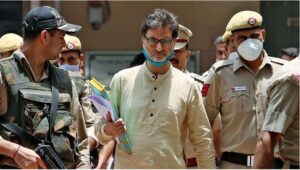The kidnapping of Rubaiya Sayeed in 1989 and subsequent success of terrorists in getting able to rerelease 5 dreaded terrorists motivated terrorists that became the source of forced exodus of Kashmiri Pandits. Discover the horrific story that has a devastating impact on Kashmiri Pandits.
On December 8, 1989, Kidnapping of Rubaiya Sayeed, the 23-year-old daughter of then-Indian Home Minister Mufti Mohammad Sayeed, was done by Kashmiri separatist militants. The kidnappers demanded the release of five jailed members of the Jammu Kashmir Liberation Front (JKLF) in exchange for Sayeed’s release. Know How?

IMAGE COURSEY: NAVBHARAT TIMES
The kidnapping of Rubaiya Sayeed, the daughter of then-home minister Mufti Mohammad Sayeed, on December 8, 1989, set the stage for a tragic turn of events in Kashmir. This watershed moment in the Kashmir insurgency not only emboldened militants but also led to a wave of violence against the Kashmiri Pandit community, ultimately resulting in their forced exodus from the Kashmir Valley.
It is noteworthy that The kidnapping of Rubaiyya Sayeed occurred shortly after the Janta Dal party took power. In response, the Vishwanath Pratap Singh government swiftly called a Cabinet meeting, attended by prominent figures such as Arun Nehru, Arif Mohammad Khan, and Inder Kumar Gujral, to discuss strategies for resolving the kidnapping. The Jammu and Kashmir Chief Secretary, Moosa Raza, established a special cell to handle the crisis.
Who was heading the Government then?
At the time of the kidnapping of Rubaiya Sayeed, the coalition government in Jammu and Kashmir was led by Dr Farooq Abdullah, affiliated with the Congress party. However, tensions were already high between Farooq Abdullah and Mufti Mohd Syed, the Home Minister of India, due to their longstanding animosity towards each other. There were rumours that Abdullah would be removed from his position, and Mufti Syed held him accountable for the sporadic violence in Kashmir.
Role of Moosa Raza
Moosa Raza, the chief secretary of Jammu & Kashmir, revealed in his book- Kashmir: Land of Regrets that during his meeting with Mufti Syed to discuss the kidnapping of Rubaiya Sayeed , the latter displayed no signs of nervousness or agitation. Meanwhile, Raza travelled to Delhi to meet with the cabinet secretary and remained in contact with the Jammu and Kashmir home secretary and director-general of police, who informed him about the JKLF’s demands for the release of certain individuals in exchange for Rubaiya’s freedom.
Among the individuals who demanded for release were Abdul Hamid Sheikh, Gulam Nabi Bhat ( Younger brother of Maqbool Bhat), Noor Ahmed Kalwal, Javed Zargar, and Mohd Altaf.
Abdul Hamid Sheikh had sustained severe injuries in a police encounter and was undergoing treatment at the Sher-e-Kashmir Institute of Medical Sciences in Srinagar. It was later discovered that his hospitalisation was part of a scheme orchestrated by Dr Guru, a prominent surgeon in the state. The situation was complex, and Raza encountered various challenges in his efforts to secure Rubaiyya’s release. Nevertheless, Raza’s account provides insights into the intricate circumstances surrounding the kidnapping and the attempts to resolve the situation.
During the negotiations for Rubaiya Sayeed’s release, the JKLF presented several demands to the authorities, including the release of Javed Zargar. However, at a certain point in the negotiations, the JKLF altered their request and instead asked for the release of Abdul Ahad Waza. To fully comprehend the significance of this change in demands, it is necessary to delve into the history and background of the JKLF.
Rubaiyya Sayeed’s crisis management strategy involved Justice M L Bhat of the Allahabad High Court as a mediator between the government and the JKLF terrorist organisation. Through the efforts of the mediator and the government, five militants were released on December 13, 1989. The news of their release was met with great joy, and thousands of young men gathered at Rajouri Kadal to celebrate their release.
However, the release of these militants on 13th December, 1989 had a negative impact on the situation in Kashmir. It emboldened the JKLF and other militant organisations, leading to increased attacks on government officials and Kashmiri Pandits. This created a dangerous situation where the insurgent movement gained momentum, becoming a turning point in the conflict.
The celebration of the militants’ release was marked by singing, dancing, and the raising of anti-India slogans. The term “Indian dogs” was used derogatorily to refer to the security forces trying to counter the insurgent movement, and this term was scrawled on the walls of Srinagar. Overall, the release of the militants had far-reaching consequences that exacerbated the situation in Kashmir.
The situation in Jammu and Kashmir might have been different if VP Singh’s government had not acquiesced to the demands of the JKLF. If the BJP had withdrawn its support on the issue, the outcome might have been different, but they chose to remain supportive, and did not consider taking off support from VP Singh Government. Rather they preferred to take off support later when When Lal Krishna Advani was arrested during the Rath Yatra
Role of Politicians
The kidnapping of Rubaiya Sayeed by JKLF in 1989 was a turning point in the Kashmir conflict. The National Conference and Congress government, which were in power at the time, were widely criticized for releasing dangerous militants in exchange for her release. This decision emboldened the militants and led to an increase in violence against Kashmiri Pandits.
The BJP, which was the main opposition party at the time, also played a role in the escalation of violence. The party remained silent when the militants kidnapped Rubaiyya Syed, and did not take off the support to the Janta Dal, but took off support when Advani was arrested by Ladu Prasad Government in Bihar during his Rath Yatra.
later BJP formed a coalition with the PDP, a party that was responsible for its links with the terrorists and doing a fake drama of Rubaiyya Sayeed Kidnapping.
The BJP’s actions in the aftermath of the kidnapping of Rubaiyya Syed showed that the party was more interested in power than in protecting the Kashmiri Pandits. The party’s silence and its willingness to work with the PDP helped to create the conditions that led to the genocide of Kashmiri Pandits.
The kidnapping of Rubaiya Sayeed was a tragic event that had a devastating impact on the Kashmiri Pandit community. The BJP’s actions in the aftermath of the kidnapping showed that the party was not interested in protecting the Kashmiri Pandits, but rather in using them for political gains, which is still continuing.
Will the Kashmir conflict ever be resolved peacefully?
For more information on the Kidnapping of Rubaiya Sayeed, Read my book “ Uprooted and Forlorn: The Tale of Kashmiri Pandits in Exile



Pingback: Yasin Malik: A Life of Violence and Conviction - Kashmiri Pandits
Pingback: Bitta Karate: A Chilling Tale of Terror in Kashmir - Kashmiri Pandits
Pingback: BJP's Role in Kashmiri Pandit Exodus - Kashmiri Pandits
Pingback: Prime Minister during Kashmiri Pandit Exodus
Pingback: role of Farooq Abdullah in the Kashmiri Pandit Exodus 1990